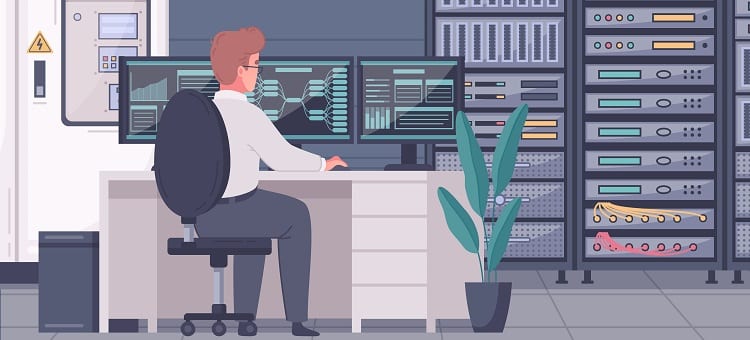Have you been bothered about your company’s data security or centralizing different IT solutions? With VDI, you can focus on the core business activities without stressing about these problems.
Managing and monitoring a desktop environment gets effortless with Virtual Desktop Infrastructure (VDI). It has become indispensable to organizations because it removes all barriers for users to accessing their desktops remotely.
This article will give you a better understanding of VDI so your business can benefit from it. Firstly, you will get an overview of the several components that creates a successful VDI. Further in the article, you will have a nuanced analysis of why VDI is significant in today’s working environment.
- Components of VDI
- Virtualisation Platform
- Display Protocol
- Connection Broker
- Application Virtualization
- Points of Access
- Benefits of VDI Deployment
- Mobility of the Workforce
- Centralised Management System
- Increased Accessibility and Flexibility
- Lowered Risk of Cyber Security
- Efficient Support, Disaster Management and Recovery
- Cost Effectiveness
Components of VDI
A Virtual Desktop Infrastructure is a seamless alternative to the conventional desktop setup. Some key elements responsible for providing businesses with this remarkable virtual solution are listed below:
1. Virtualisation Platform
- A virtualization platform is a must-have for hosting VMs with client operating systems.
- It consists of a hypervisor that breaks the servers into VMs that host virtual desktops for clients to access remotely.
- Server virtualization ensures the security of data stored in an OS from hardware failure.
- Examples include VMware ESX Server, Hyper-V, etc.
2. Display Protocol
- As the name suggests, display protocol allows end-users to view their virtual desktops.
- Selecting a proper remote display is essential for every VDI for tackling features like device redirection. It can be accomplished by researching target end-users and the device they will use to connect.
- Examples of display protocol technologies include Microsoft’s Remote FX, Citrix Systems’ GDX, VMware’s PC over IP, and so on.
3. Connection Broker
- A session broker acts as an intermediary between clients and virtual machines.
- The broker is critical in distributing sessions between the end user and the VM.
- It discovers a suitable target operating system where connection can be redirected and ensures they connect with the right virtual desktop.
- The connection broker also manages desktop provisioning, authenticates the user, and tracks its status accordingly.
4. Application Virtualization
- While installing an application, the standard way can consume a lot of your time and effort. Application virtualization is recommended to prevent time loss and poor user experience.
- It is a crucial part of VDI to regulate the application installation process speedily.
- The rapid availability of applications to virtual operating systems enhances the productivity and satisfaction levels of the end user.
- It is significant to deploy application virtualization in this hybrid working environment to fasten business processes.
5. Points of Access
- These are client devices that provide end-users access to their virtual desktops.
- Points of access incorporate various client devices, including thin clients, zero clients, web browsers, laptops, etc. These devices could also be clients running software on operating systems such as Windows, Linux, etc.
Benefits of VDI Deployment
A plethora of advantages can be achieved using a VDI, especially when employees prefer working remotely. Some of these perks have been enlisted in the following pointers:
1. Mobility of the Workforce
A VDI facilitates workforce mobility by hosting desktops virtually. Workers gain agility when they are allowed to work from anywhere, they prefer, without restrictions. When end-users leverage from working remotely, their productivity amplifies manifold.
With virtualization technology, work can flexibly be done over PCs, laptops, smartphones, etc. VDI also helps companies expand and recruit a diversified workforce from across the globe.
2. Centralised Management System
An added benefit of deploying a VDI is to simplify the business processes. It is extremely convenient to track the data accumulated at a central location. Having hassle-free access to indispensable company data enables employees to focus on their core business activities.
VDI automatically processes employee data and installs updates on individual virtual desktops, thus saving time on redundant tasks.
3. Increased Accessibility and Flexibility
Another reason why every business should have a VDI is for easy of accessibility and increased flexibility. The end-users or company employees must have access to their desktop environment when required. VDI enables end-users to achieve this & over multiple devices. With remote access to desktops, employees can deliver great productivity.
4. Lowered Risk of Cyber Security
As small businesses progress into enterprises scale, their critical data becomes increasingly prone to cyber-attacks and accidental data infringement. Undertaking accurate preventive measures becomes a priority.
The purpose of VDI is to host a desktop environment from a centralized infrastructure. This centralized data management and storage comes with inherent security benefits. As company data is not scattered but available under one infrastructure, it can leverage increased digital safety.
5. Efficient Support, Disaster Management and Recovery
Supporting an IT infrastructure is an equally important requirement. Whether you run an in-house IT team or you’re outsourcing desktop support, in both cases, the total cost of managing a VDI is significantly lower than a conventional desktop environment.
While working in a hybrid mode, maintaining a disaster recovery plan is of utmost importance. VDI not only hosts desktops in your data center or managed data centers, but also offers manages unforeseen disasters.
VDI maintains data integrity and makes it easy to backup & restore data. It is seamlessly & quick. Also, having a centralized platform for disaster recovery proves to be more coherent than physical desktops.
6. Cost Effectiveness
Bearing the cost of standardized desktops or hardware for each employee can hinder an organization’s progress. An excellent alternative to the conventional IT setup is a Virtual Desktop Infrastructure.
VDI is an asset to any organization as it requires less maintenance, is less expensive, and provides more benefits than regular hardware. The initial cost of setting up a host server can be high, but VDI is cost-efficient in the long run. Moreover, the overhead licensing costs become minimal because of a single virtual setup.
Key Takeaways
After considering every aspect, VDI seems to have very few or no downsides. Collaborating with a Virtual Desktop Infrastructure can be a sure-shot solution to the IT department problems for your company. It offers advanced benefits, including automated back-ups, manageability, resource and cost efficiency, data maintenance, and security, among others.
The boundless perks that stem from a VDI make it apparent that it is an impeccable way to operate a business. So, transfer your desktop management from the standardized environment to a virtualized one and see your enterprise achieve many milestones.







